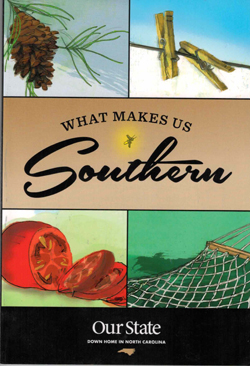By Donald H. Harrison

 SAN DIEGO – Although I have known Nancy more than 50 years, and have been married to her for 48 plus, Gayle Midyette has even more bragging rights. She has known Nancy 60 years, ever since the Brownies matched them up as pen pals. They’ve only met in person a few times, but they have faithfully written to each other through marriages (both picked husbands named “Don”), births, children’s marriages, grandchildren and, sadly as well, through deaths in their families.
SAN DIEGO – Although I have known Nancy more than 50 years, and have been married to her for 48 plus, Gayle Midyette has even more bragging rights. She has known Nancy 60 years, ever since the Brownies matched them up as pen pals. They’ve only met in person a few times, but they have faithfully written to each other through marriages (both picked husbands named “Don”), births, children’s marriages, grandchildren and, sadly as well, through deaths in their families.
Gayle lives in North Carolina, in the gentle former colonial capital of New Bern, and this year she kindly sent us for Chanukah a book that perhaps provides some insight into her lifestyle versus ours, out here on the West Coast. Titled What Makes Us Southern: Our State, Down Home in North Carolina, it is a collection of 15 essays by a variety of authors about various facets of Southern life.
The Table of Contents lists them: Southern Hospitality, Tomato Sandwich; Red Clay; Clotheslines; Barbecue; Longleaf Pine; Sweet Tea; Front Porches; Banjo; Carolina Rails; Moonshine; Spanish Moss; Hammocks; Sunday Drives; and Lightning Bugs.
The chapter on barbecue was interesting to this Jew from what you might call a sociological viewpoint. Not one who eats pork, I couldn’t take sides in what essayist Jimmy Tomlin described as an ongoing battle between those who live in eastern North Carolina, and those who live in the western portion. Easterners, it seems, go whole hog, that is when they serve barbecue, it may include “meat from the shoulders, hams and loins.” For westerners, barbecue means “strictly pork shoulders.” Gai gezunterhait (“go in good health”), I say.
Scott Huler’s essay on the ubiquitous tomato sandwich informs us that in its truest form, the North Carolina favorite consists of “two pieces of white bread: Merita, say, or Wonder; maybe Bunny, if you’re from Tennessee. Duke’s mayonnaise – and only Duke’s mayonnaise… A thick slice of tomato, dripping oozy goodness. A little salt and pepper, if you like.” I checked on Wikipedia and found that Duke’s label includes a hechsher from the Orthodox Union.
There’s no reason those sandwiches can’t be accompanied by sweet tea, which essayist Tommy Tomlinson declares “is more than just a drink. Sweet tea is our alchemy – our gift of making something special from humble ingredients. (Just like barbecue, conjured into glory from the cheapest cuts of meat.) Sweet tea is our love offering, poured for family and neighbors and even the guy trying to sell us new gutters. And at its most basic, sweet tea is a cold blast on a hot day, like a dip in a river from the inside out.”
Tomlinson’s description of sweet tea segues perfectly into the essay by Huler (of tomato sandwich fame) about Southern hospitality, which though usually endearing and well intentioned, can sometimes be carried to an extreme. He told of one four-hour dinner that was more “hostage drama” than “Southern hospitality” in which the message to the guests seemed to be “Stick around whether you like it or not; you are going to sit there and claw your way through our food performance, and our three different dessert services, and we’ll tell you when you’re full.” In its more moderate form, Southern hospitality may mean endless refills of coffee or soda at the local restaurant, and no pressure whatsoever on diners to finish so their tables can be turned over.
No discussion of southern food and drink would be complete without some consideration of moonshine, which essayist Tomlinson warns us should not be gulped or “you’ll be spitting and snorting half the night. Just let a little bit slide between your lips. That peeled peach, looking like Mars floating around in there, sands off some of the hard edge. You might even taste the fruit first. But right behind it comes the fire. It’s not a big roaring flame like the old days — that old 140-proof white lightning is hard to find anymore. This is more like 80…”
North Carolina’s good earth and some of its flora and fauna are addressed in this 95-page booklet. Chip Womick, writing about the red clay of the Tarheel State, notes that the color indicates its iron content, and that while it sometimes is difficult to coax crops from the red clay, it lends itself well to the potter’s wheel. He enthuses: “In central North Carolina, red clay is the sod beneath our feet, the bed from which nourishment springs, a source of work and of art. And for those of us whose roots are planted here, it colors who we are.”
Jim Dodson is equally lyrical about the longleaf pine, writing that “for centuries, the pines have towered over the sandhills. They anchored our state’s nascent economy and, to this day, harbor life.” He recommends visiting the Weymouth Center for the Arts, where a bridle path will lead one to “one of the few remaining stands of old-growth longleaf pines on the planet, surviving elders of a vast forest of the legendary tree that once covered an estimated 90 million acres of southeastern America.” Today, Dodson reports, the domain of the longleaf pines has dwindled to two million acres.
Spanish moss is another feature of the North Carolina landscape, with Michael Parker informing that it really “is neither Spanish nor, technically, moss.” There are legends about how this angiosperm which drapes itself over the branches of trees got its name; one being that a local man’s Spanish fiancée was killed by Cherokees, who then “cut off the Spanish woman’s long black tresses and tossed them onto the branch of a live oak, where they turned grey and spread across the Southeast.”
The DuPont State Forest is a wonderful place for finding lightning bugs, according to essayist Diane Summerville. At night it gets pitch-black dark, all the better to see the blue ghost firefly, which in fact is a tiny and remarkable beetle. “Unlike the fireflies we chase in our front yard, this one stays lit for several seconds, sometimes as long as a minute. It doesn’t twinkle so much as streak. And although the blue ghost—named for its bluish cast—is the size of a piece of rice, its light illuminates brush and trees…”
Food and the natural environment are part of “What Makes Us Southern,” but there also are the devices that humans have invented that also have made North Carolina what it is today. I’m talking about such familiar items as clotheslines, front porches, and hammocks; banjos which twang with happiness; and vehicles for traveling from one North Carolina venue to another, such as railroads and the cars that folks just love to take out for a spin every Sunday.
A clothesline, suggests essayist Robert Long, is not simply for drying clothes in the sun. “It tells you something about your neighbors, and it tells them something about you. …” What better time to have a conversation with a neighbor than when hanging clothes, who only a few yards away might be doing the same thing?
Tim Bass says front porches are representative of a bygone era, when people had time after dinner to sit a spell, talk, and enjoy their rocking chairs. And the porches’ disappearances are too bad, he says, quoting a teenager who enjoys the front porch of his aunt’s older home. “We’ve been so occupied with technology and stuff. I think we need to have some outside time, to get away from some things.”
Another way to “get away” in essence is to stay put. Duncan Murrell writes that “a hammock does not yield easily to our impulse to rush off. Enforcing a slow Southern pace, its knotted web cradles us, convincing us it’s better to stay put for a while longer.”
Like the front porch, a banjo evokes an earlier time and place, according to essayist Nic Brown. “Pluck one string, and images start forming; rural family gatherings, dirt-floor dances, and simple picking on a porch as the sun sets. Few instruments conjure place more powerfully than the banjo.”
But let’s say that we actually want to get away from the front porch, the hammock and the banjo. What’s the best North Carolina way to go?
Jeremy Markovich essays that while it is “long past its prime as the way to travel, a train charging across a field or a city street still has the power to transport us to places beyond its destination.” He adds: “Trains are more than mighty. They are time machines.”
Michael Parker is similarly nostalgic about impromptu trips in the family car. Such rides were a form of leisure – “to get out of the house, to open the car windows wide in those pre-air-conditioned days and whip up a summer breeze, to wander. … That so many of our rides took place on Sunday afternoon suggested to me, much later, that going to ride was a secular extension of the morning of worship. If true religion requires a vigilant attentiveness to the world around you, its changes and its failings, going to ride was a journey through examples – of the beauty of nature, of the occasional sign of greed, of the duty emphasized by more enlightened churches to the community …”
All 15 essays are well worth reading in their entirety; they are reflections not on the tourist meccas of North Carolina – of which there are many – but rather about the state’s indigenous warp and woof. Copies may be obtained through http://www.ourstatestore.com/ My thanks to Gayle and Don Midyette for this fine surprise gift.
*
Harrison is editor of San Diego Jewish World. He may be contacted via donald.harrison@sdjewishworld.com